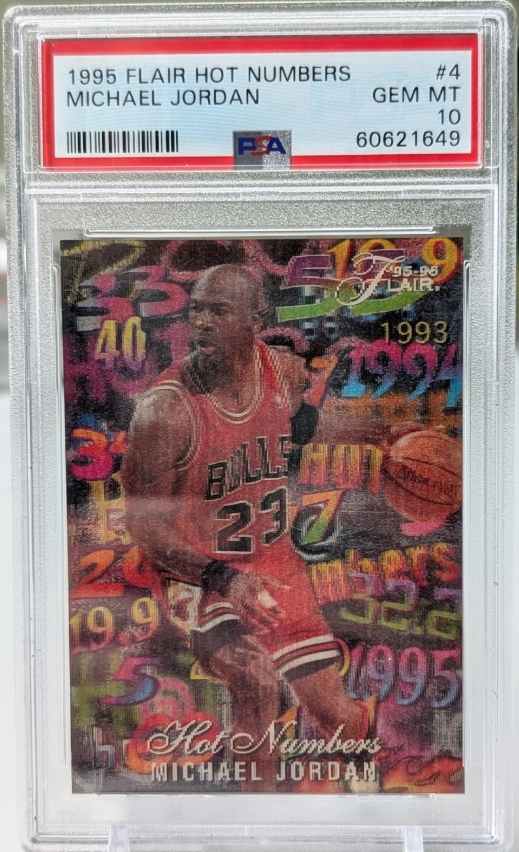In the world of sports memorabilia, few items resonate with the same intense allure as Michael Jordan’s 1995–96 Flair Hot Numbers insert card. A gem among collectors, this iconic piece bridges the gap between vivid nostalgia and enduring appeal, drawing eyes with its kaleidoscopic design even when tucked safely away in its protective slab.
This basketball card, significantly numbered as card 4, has all the makings of an unintentional showstopper. Thanks to the ingenious lenticular printing, it dances with light much like a vibrant scoreboard at a final buzzer. The brilliance of the card isn’t just in the play of light—it’s embedded in its very DNA, as it arrived amidst the zenith of the Chicago Bulls’ illustrious streak, the team riding high with Michael Jordan at the helm.
In 1995, Flair embarked on a fervent quest to demonstrate that premium paper products could stand shoulder-to-shoulder with the burgeoning craze of chromium cards. The Hot Numbers series became their rallying cry, comprising a curated line-up of 15 cards that combined scarcity with the sensory excitement of lenticular technology. Even by those ambitious standards, the Jordan card soared above its contemporaries as a beacon of the era’s stylistic ambition.
The truth is, stumbling upon a Hot Numbers card in the wild has always been a serendipitous event. With their rate of appearance set at a daunting one card per 36 packs, a full box could be methodically opened without the telltale gleam of an MJ insert ever appearing. This rarity has only amplified its market desirability over the years. To add this card to your collection is to stake a claim in a time where vibrant, maximalist designs reigned supreme and basketball cards verged on mini canvases of pop art.
Collectors covet a PSA 10 graded version of this card with the same fervor as an art collector might seek a missing piece for their gallery wall. The market for these high-grade specimens orbits around the four thousand dollar range, with auctions occasionally breaking into higher altitudes, like the summer sale noted by Card Ladder, peaking at approximately four thousand eight hundred dollars. Besides, with the auction scene providing a dynamic marketplace, seeing prices gracefully teeter around that threshold feels apt.
The detailed design itself—a symphony of sharp angles and an inter-playing, loud number motif—demands attention. It resonates deeply with collectors who matured during the zenith of the 90s, while enticing newer aficionados who have come to idolize the decade’s characteristic flair through viral platforms and retrospectives on ultra-rare cards like the Jambalaya and Precious Metal Gems (PMG) varieties.
Another facet of this card’s magnetism lies in its testament to Flair’s inspired pivot towards beefed-up paper stock rather than succumbing entirely to the chrome tidal wave. This wasn’t just a card; it was a challenge to traditional sports collectibles, showing that abstraction could offer its own form of shiny intrigue without having to morph medium entirely.
While displaying your collection chronologically may seem the most logical approach, a card like this embodies multiple narratives. It’s a stand-out in 90s inserts, complementing series such as New Heights and Scoring Kings, yet it coexists harmoniously within a broader collection of Jordan’s career memorabilia—a spirited cousin to the Bashful-led, photo-centric base cards.
The card’s market valuation follows a well-trodden path, its familiarity providing a steadying comfort to both new and seasoned collectors. Auction sites like eBay depict a consistent four-thousand-dollar valuation rhythm for PSA 10s. Yet, much like a masterpiece waiting to be discovered, choice pieces—those unmarred by the passage of time—can eclipse these values when two determined bidders lock horns.
However, the road to a mint card is rarely straightforward. Those lambent lenticular surfaces need expert eyes and a trained tilt to reveal hidden imperfections. The edge whispers tales of past care, or lack thereof, and although slabs offer reassurance in grading, seasoned collectors know there’s no substitute for a keen appraisal.
A pivotal question often asked by prospective buyers remains—the thrill of the hunt. Even now, chances of pulling a Hot Numbers card from supply packs such as the Galaxy Rip Packs draw parallels to a lottery of ephemera. Each potential pull invokes memories of the 90s, with cadres of collectors gathering to admire and deliberate the luminescent wonder of an MJ card brought out from its cardboard confines.
Ultimately, one doesn’t merely own an MJ Hot Numbers card; one proudly enlists in a legacy substantiated by a delicate blend of scarcity, historical significance, and the irresistible pull of its mesmerizing visage. Display it proudly or slot it alongside its insert cousins, and it remains a visceral nod to the expressive zeitgeist of the mid-90s—a masterpiece enshrined not only in paper and lenticular magic but firmly within the annals of collector lore.





